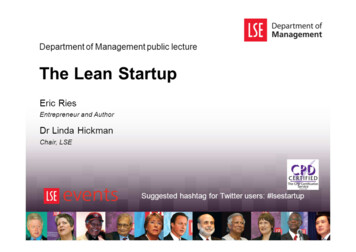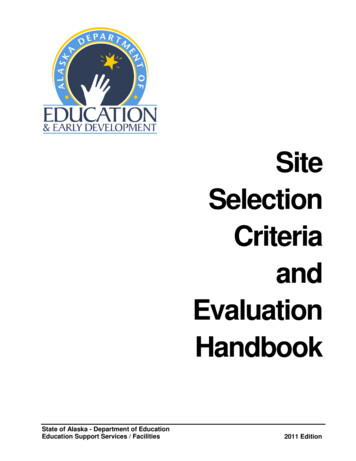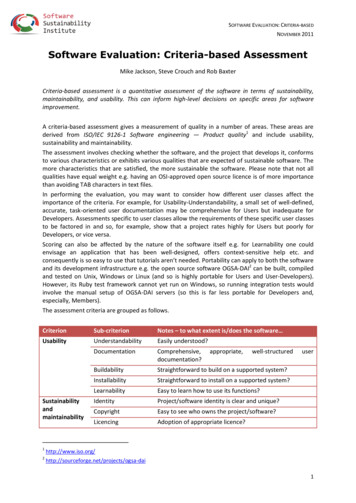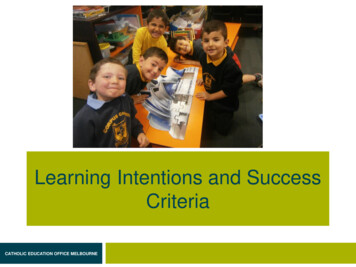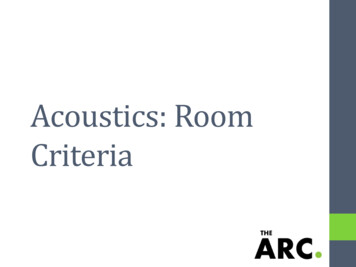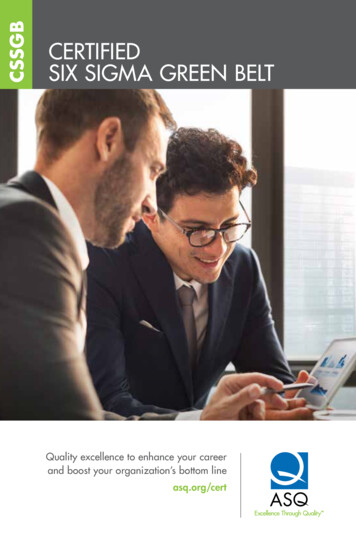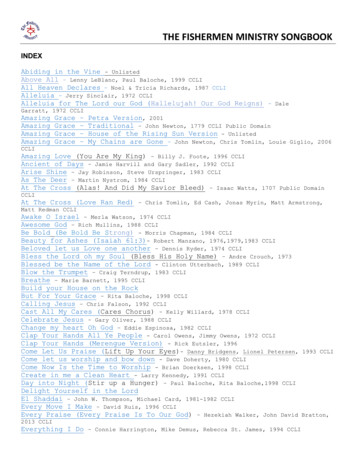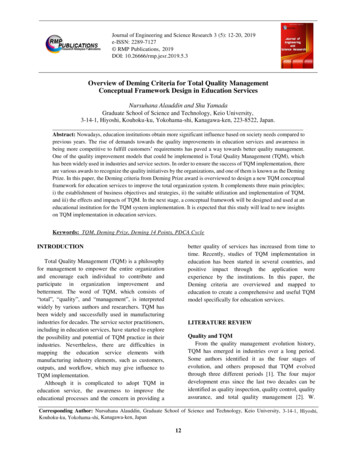
Transcription
Journal of Engineering and Science Research 3 (5): 12-20, 2019e-ISSN: 2289-7127 RMP Publications, 2019DOI: 10.26666/rmp.jesr.2019.5.3Overview of Deming Criteria for Total Quality ManagementConceptual Framework Design in Education ServicesNursuhana Alauddin and Shu YamadaGraduate School of Science and Technology, Keio University,3-14-1, Hiyoshi, Kouhoku-ku, Yokohama-shi, Kanagawa-ken, 223-8522, Japan.Abstract: Nowadays, education institutions obtain more significant influence based on society needs compared toprevious years. The rise of demands towards the quality improvements in education services and awareness inbeing more competitive to fulfill customers’ requirements has paved a way towards better quality management.One of the quality improvement models that could be implemented is Total Quality Management (TQM), whichhas been widely used in industries and service sectors. In order to ensure the success of TQM implementation, thereare various awards to recognize the quality initiatives by the organizations, and one of them is known as the DemingPrize. In this paper, the Deming criteria from Deming Prize award is overviewed to design a new TQM conceptualframework for education services to improve the total organization system. It complements three main principles;i) the establishment of business objectives and strategies, ii) the suitable utilization and implementation of TQM,and iii) the effects and impacts of TQM. In the next stage, a conceptual framework will be designed and used at aneducational institution for the TQM system implementation. It is expected that this study will lead to new insightson TQM implementation in education services.Keywords: TQM, Deming Prize, Deming 14 Points, PDCA Cyclebetter quality of services has increased from time totime. Recently, studies of TQM implementation ineducation has been started in several countries, andpositive impact through the application wereexperience by the institutions. In this paper, theDeming criteria are overviewed and mapped toeducation to create a comprehensive and useful TQMmodel specifically for education services.INTRODUCTIONTotal Quality Management (TQM) is a philosophyfor management to empower the entire organizationand encourage each individual to contribute andparticipate in organization improvement andbetterment. The word of TQM, which consists of“total”, “quality”, and “management”, is interpretedwidely by various authors and researchers. TQM hasbeen widely and successfully used in manufacturingindustries for decades. The service sector practitioners,including in education services, have started to explorethe possibility and potential of TQM practice in theirindustries. Nevertheless, there are difficulties inmapping the education service elements withmanufacturing industry elements, such as customers,outputs, and workflow, which may give influence toTQM implementation.Although it is complicated to adopt TQM ineducation service, the awareness to improve theeducational processes and the concern in providing aLITERATURE REVIEWQuality and TQMFrom the quality management evolution history,TQM has emerged in industries over a long period.Some authors identified it as the four stages ofevolution, and others proposed that TQM evolvedthrough three different periods [1]. The four majordevelopment eras since the last two decades can beidentified as quality inspection, quality control, qualityassurance, and total quality management [2]. W.Corresponding Author: Nursuhana Alauddin, Graduate School of Science and Technology, Keio University, 3-14-1, Hiyoshi,Kouhoku-ku, Yokohama-shi, Kanagawa-ken, Japan12
Nursuhana Alauddin / Journal of Engineering and Science Research, 3(5) 2019, Pages: 12-20Edwards Deming, Joseph M. Juran, Armand V.Feigenbaum and Philip Crosby are the big names whohave majorly contributed and played essential roles inshaping the quality management, especially the TQMas of today.The word “quality” itself can be defined in differentperspectives and dimensions as it is a relative conceptby different people. Deming [3] emphasized thatquality is all about people and not products. Thesatisfaction of the customers defines quality, and sincethe customers’ needs and expectations are alwayschanging, the organization has to adapt and respond tothose changes. The ideology of Deming 14 Points is toimprove the effectiveness of an organization or abusiness significantly. Juran interpreted quality in twomeaning; the features of products which meet customerneeds, thereby provide customer satisfaction and thefreedom from deficiencies. Quality may be defined asfitness for use, and it only can be assessed on a deepunderstanding of the particular customers and theirneeds. Moreover, the process of managing qualitymakes extensive use of the three managerialprocedures; quality planning, quality improvement,and quality control, also known as the Juran Trilogy[4].Feigenbaum [5] highlighted that the total qualitycontrol is an effective system for integrating the qualitydevelopment, quality maintenance and qualityimprovement efforts by various groups of people in oneorganization to fulfill the customer satisfaction. On theother hand, Crosby [6] defined quality as conformanceto the requirement to improve quality and eliminatehassle at the same time. The “do it right from the firsttime,” or DIRFT is when the requirements are clearlyunderstood and not putting things in people’s way.Also, he created a Zero Defects concept in 1961, whichrelates to the DIRFT idea.JUSE [7] expressed quality as the degree to indicatewhether it is good or bad overall, by gathering thevarious requirements of such evaluators. As in Japan,the quality word itself has two interpretations based onthe different industries; in the manufacturing industryand service sector as the term “quality” is defined with“product quality (品質)” and “quality (質)”. However,deliver knowledge and information transmission, iscategorized under the service sector, which providesintangible products to customers [9].JUSE interprets TQM as a collection of ideas,initiatives, methods, mechanisms, and methodologiesfor maintaining and improving overall “quality” incorporate activities. These efforts will then shapecorporate events toward the achievement ofmanagement goals [7]. TQM implementation has beenadopted with its roots in manufacturing [10], later on,spread into services and healthcare [11], and recentlyhas been penetrated in government and educationsectors [12]. Since the TQM concept was initiallydeveloped for the manufacturing industry, therefore,there is a great deal of concern whether this philosophyis applicable in education or not. The organizationsrelated to education might have a hard timeimplementing TQM in their services as of its nature,and the process of delivery is not similar to theindustrial area. In [13], the significant differencebetween school and manufacturing company in term ofprocesses involved in each sector was presented,especially the engagement with the customers. It showshow complicated the education process is to implementTQM if the philosophy behind it is not well-defined.TQM is defined as a set of systematic activitiescarried out by the entire organization to effectively andefficiently achieve the organization's objectives toprovide the products and services with a level of qualitythat satisfies customers, at the appropriate time andprice. Through this definition, seven important phrasesneed to be focused, and the Deming Prize committeedescribes further explanations in the Deming Prizeapplication guidelines [14]. TQM has the basicviewpoints of “customer orientation”, “respect forhumanity”, and “profitability”. Based on thisperspective, various efforts in increasing themotivation and awareness of the entire company willbe carried out.Nevertheless, a plethora of studies for TQMimplementation in education services, especially inhigher education institutions, were being conducted inseveral countries. Some authors implemented TQM asa tool to improve the quality of primary educationsystem, including the improvement of classroomenvironment quality through 5S in motivating studentsto go to school [15]. In [16], the TQM core elementssuch as leadership, strategic planning, and focus ofcustomer satisfaction, that can be used as selfassessment practice in higher education institutionsafter all, it is all set as the word “quality” in English [8].It is interesting as the involvement of the product to bedelivered to customers is categorized as tangible orintangible. Based on ISO 9000 in clause 3.7.7, theservice organization such as the educational bodies that13
Nursuhana Alauddin / Journal of Engineering and Science Research, 3(5) 2019, Pages: 12-20was highlighted. Besides, [17] emphasized that thereare nine steps of TQM model for higher educationinstitutions. Through the steps, after obtaining the topmanagement commitment to determine the mission andvision statement in stage 2, the customer definition isdetermined through customer surveys or customerneeds in step 3.Unfortunately, most of the literature focused on theimplementation of TQM with various tools andprocesses to improve education system through TQMcore values without further explaining on how toachieve the mission and objectives of the school oreducation institution. Quoted the general TQMdefinition by the Deming Prize committee, the mainidea of TQM implementation in the education contextis to achieve school objectives and strategy by thesupports of TQM processes or tools. Besides, thecustomer definition shall be considered during theformulation of school objective and strategy, whichmeans the school objective and strategy must becustomer-oriented.To ensure the TQM implementation is successfuland provides positive impacts to the businessobjectives, the quality award is introduced. There arevarious awards from different countries and regionssuch as the Deming Prize, Malcolm Baldrige NationalQuality Award (MBNQA), and the EuropeanFoundation for Quality Management’s Excellence(EFQM) award. These awards are being used by theorganizations in both the private and public sectors toconductself-assessmentstomeasuretheirimprovement progress and company potential [18]. Inthis paper, the framework is proposed from theperspective of TQM implementation by theunderstanding of the Deming criteria in Deming Prize.education service [19]. As such, it is worth tobenchmark the success of the manufacturing andservice sectors who have won this award to createexcellent education services.Compared to other quality awards, the DemingPrize has a unique way of assessment and evaluationprocess. Koura mentioned that the MBNQA andEFQM are used as self-assessment evaluation forcompanies that pursuing business excellence. On theother hand, for the Deming Prize, it is focusing on theconcept of TQM at the operation site [20]. Izadi et al.stated that the Deming Prize application process ischallenging. It usually takes three to five years for themanagers to convince the Deming Prize committee toconduct the assessment and examination at thecompany site. The examination process is carried outby the experts of TQM, and they will audit the qualitysystem carried out in the applicant’s company [21].The Deming Prize Committee views the process ofexamination as an opportunity for “mutualdevelopment,” rather than “examination.” They do notspecify what issues need to be addressed, but theapplicants themselves are responsible for identifyingsuch problems. Thus, this process allows qualitymethodologies to be further developed by thecompanies, which helps to strengthen their capabilities.The applicants could use the Deming criteria as theguidelines, and they should embrace TQM as themanagement philosophy to be more successful.Philosophy of Deming 14 Points and PDCA CycleDeming 14 Points, as shown in Fig. 1, is vital inaiming to make people work with joy. Stressing the roleof management in leading the comprehensive andcontinues improvement of the system and thecontinuous development of people. It can be appliedanywhere, to small organizations as well as to largeones, to the service industry as well as tomanufacturing. Perhaps, the Deming philosophy is thekey feature of the Deming Prize. The method promotesself-discovery in a company to embed the continuousimprovement processes and ensure the organization’ssurvival even if there is a change of leadership [18].Several authors were using Deming 14 points todeploy the understandings to be used at school levelsand higher education institutions. Lunenburg suggestedthat Deming 14 points could be used as a basis forachieving excellence in schools [22]. Hughey furtherexplained how each of the 14 points is useful to makemore exceptional quality, accountability, and fulfillDeming Criteria in Deming PrizeDeming Prize is one of the highest TQM awards inthe world. It is established in 1951 in thecommemoration of the late W. Edwards Deming, whomajorly contributed to Japan’s proliferation ofstatistical quality control after World War II. He helpedJapan in building its foundation by which the level ofJapan’s product quality has been recognized as one ofthe highest globally. Based on statistic available atJUSE website, as in 2018, there are 252 organizations,including 55 oversea companies, has won the DemingPrize award. Among all, 98% of the winners are themanufacturers in Japan and other countries; only fiveof them are from service sectors and none from14
Nursuhana Alauddin / Journal of Engineering and Science Research, 3(5) 2019, Pages: 12-20customer satisfaction in higher education [23]. Farooqet al. [24] agreed that focusing on TQM is thefundamental way of fulfilling the accountability toreform the education, especially the no-fear TQMsystem in Deming 14 points. Each point in Deming 14points would have its interpretation and perspectives ineducation services based on cases and context. Theexample of TQM practice in secondary school fromDeming principles is explained in [25], and it utilizedthe exploratory research design approach formeasurement based on a conceptual framework. All theabove authors have elaborated every single pointdifferently depending on knowledge, kinds ofliterature, and experiences.Another important philosophy is PDCA Cycle orknown as the Deming Cycle, and it emerges in theDeming criteria application process. As shown inFig.2, the Plan-Do-Check-Action is a systematic wayof managing quality and provides steps for obtainingknowledge and essential learning for the continuousimprovement of product development or process. Itstarts by identifying a goal or finding a problem,formulating the theory, and planning it into actions(Plan). The next step is to execute the planning andimplement it as decided before (Do). After that, tocontinue the evaluation of whether the desired goalshave been achieved or not (Check), and then determinewhat the necessary remedial steps are to achieve theirgoals (Action). These are the four steps that will berepeated all over again as part of a continuousimprovement in every process [26]. The relationshipbetween Fig. 1 and Fig. 2 with the Deming criteria iselaborated in the next section.MAPPING OF DEMINGEDUCATION SERVICESCRITERIAINDeming Criteria and its EvaluationBased on Deming Prize [14], Deming criteria arecategorized under three main categories, which are A,B, and C. The “A category” describes the clearobjectives defined by the top management, whichreflects into management philosophy, industrial scale,and environment. Moreover, the company needs toestablish a proactive customer-oriented businessobjective and strategy based on organization socialresponsibility. Besides, top management must exhibitleadership in the formulation of business objective andstrategy. The “B category” explains how TQM issuitably implemented and utilized for the realization ofbusiness objective and strategy mentioned under the “Acategory”. The “C category” shows the resultsachieved through processes in the “B category”, whichexplains the effects towards the organization, alongwith the achievement of the business objectives andstrategies of the “A category,” including theoutstanding TQM activities in the organization.Each category is designed with specific evaluationpoints to be achieved by the organization if they havean interest in participating in the Deming Prize award.Total evaluation points of the “A category” is 100points, and the same goes for the “C category”. The “Acategory” has two criteria; A1 and A2, whereas the “CFig. 1: Graphical image of Deming 14 PointsFig. 2: Graphical image of PDCA Cycle15
Nursuhana Alauddin / Journal of Engineering and Science Research, 3(5) 2019, Pages: 12-20category” is separated into the C1 and C2, as shown inFig 3. On the other hand, the “B category” is classifiedfrom B1 to B7 in Table 1. The total evaluation point forthe “B category” is 100 points. However, thedistribution of evaluation points is much more detail asit involved multiple processes to ensure the success ofTQM. It is shown in Table 1at the left column.TQM in their ways. If the education services use theDeming criteria in adopting TQM processes, theDeming criteria shall be made specific to educationservices and appropriate for the institutions’ operation.Table 1: Deming Criteria for “B category” with itsevaluation pointsCriteria withevaluationDefinition in Deming criteriapointsB1:15 pointsOrganizational deployment ofbusiness objectives and strategies.B2:15 pointsNew value creation based oncustomer and social needs’understanding and business model/technology innovations.B3:15 pointsProducts and services and workprocesses, quality management,and improvement.a. Daily work managementb. Continuous improvementB4:15 pointsEstablishment and operation ofcross-functional management.B5:15 pointsB6:15 pointsB7:10 pointsFig. 3: Overview of Deming Criteria based on thephilosophy of Deming 14 Points and PDCA CycleCollecting and analyzing theinformation from customers, andaccumulationofknowledge,including its utilization.Development and utilization ofhumanresourcesandorganizational capability.Initiatives for social responsibilityin the organization.In Fig. 3, the Deming criteria in the A, B, and Ccategory are general definitions for all sectors; inmanufacturing and services. Each criterion has itstarget result that needs to be achieved by theorganization to ensure the success of TQMimplementation. By understanding the target for eachcriterion stated in the Deming Prize [14], the generaltarget result is mapped into education services, and theeducation services target result is created. This target isto suit the environment from the viewpoint ofeducation milieus. It can be referred at Table 2. As forthe B1 (policy management) and B3a (daily workmanagement), these criteria are one of the essentialprocesses in TQM. Sachdev and Agrawal stated thatpolicy management and daily management are theIn order to build the conceptual framework, it isdesired to comprehend the whole TQMimplementation process mentioned in Deming criteria.In this study, it is interpreted based on Deming 14Points and PDCA Cycle, as suggested in Fig. 3. Itshows how each element in Deming 14 points links toDeming criteria, and the philosophy is interpreted toelements in the A, B, and C categories. The process ofimplementation follows the PDCA Cycle, and it will berepeated and continuously improve to specificstandards decided by the guidelines. If the organizationis a manufacturing entity, the Deming criteria for thecompany are in the manufacturing-based, and thecompany will have a unique way to implement the16
Nursuhana Alauddin / Journal of Engineering and Science Research, 3(5) 2019, Pages: 12-20vehicles in focusing on strategic improvement andsustenance of an organization [27].Table 2: Each Deming criteria’s target result aftermapping into education servicesCriteriaTarget resultA1The school objectives and strategies areestablished based on customer/societyoriented by the clear management belief.In this context, the customers’ definitionof education must be clearly defined; forexample, students, parents, society, etc.Moreover, the objectives and strategiesrelated to customers shall be sufficient asthe input of the process and furtherimprovement. Also, the objectives andstrategy have well-defined for next term.A2B1B2B3aTop management exhibits leadership inthe formulation of customers-basedbusiness objective and strategy,including in the TQM implementation inthe education context. The topmanagement has a concern aboutbusiness objective, strategy, andenvironmental change also shallunderstand the importance of theenhancementoforganizationalcapabilities in their organization. Also,they show enthusiasm towards TQM toachieve the business objectives.Establishment of policy managementbased on all significant schoolobjectives. Business objectives andstrategies are deployed throughout theschool levels and implemented in such away based on the involvement of totalemployees in education services, andclose cooperation with all levels andrelated organizations.*This is an important process to supportthe business objectives and itsoperation.17Development of new educationalservices and innovation of workprocesses are being carried outeffectively, aiming for the creation of thenew educational value based on theunderstanding of the customers’ needs. Itincludes the continuous improvement ofthe new educational service.Daily work management process relatedto education services’ is established. Therelated process in education, especiallyin teaching and learning process needs tobe clearly defined. Problems insignificant operations have beenstabilized throughout the process, withstandardization and proper education ortraining to employees.*This is an important process to supportthe business objectives and itsoperation.B3bContinuous improvements in the qualityof education services and work processesare being carried out in a planned mannercontinuously. The customer complaintsand next-processes are decreasing, or arebeing maintained at an extremely lowlevel. Whereas the customer satisfactionlevel has improved or is beingmaintained at an extremely high level.Known as “kaizen” in the Japanese term.B4Cross-functional management systems(such as education quality, etc.)necessary for the organization are beingestablished. The education qualityassurance system is developed andoperated suitably across the supply chainheaded to society.B5Collection of customer needs andanalysis of information is being carriedout in an organized manner. Also, suchinformation is useful in the creation ofnew educational values, managementand improvement of services, andoperational quality.
Nursuhana Alauddin / Journal of Engineering and Science Research, 3(5) 2019, Pages: 12-20B6Human resource management isavailable and practised. The process iswell-established and effective, beingcarried out in a planned manner, and it isuseful to realize the better education.B7Aware of the role in society and theschool has established the process tounderstand social responsibility andactions.Also, adopting initiativesproactively according to managementphilosophy and as the entity of theeducational service industry.C1Education organization has obtainedsignificant effects on school objectivesand strategies through suitable utilizationand implementation of TQM.C2Grand Prize category require participants to obtainmore than 70 points and 75 points for all A, B, and Ccategories, respectively. The Deming Prize is awardedto the organization that has implemented TQM suits totheir management philosophy, the scale of business andmanagement environment. For Deming Grand Prize isgiven to the organization that had maintained and alsoenhanced the TQM level for more than three yearsperiod after winning the Deming Prize.By understanding the target evaluation points,helped to design a more comprehensive conceptualframework with more sub-elements to represent TQMprocesses to be conducted by the organization.CONCLUSION AND THE WAY FORWARDThis study demonstrates the overview of Demingcriteria to construct the TQM conceptual frameworkthat suits to education services, in general. It providesthe idea of creating a more comprehensive model toimplement TQM in education, starting from thebusiness objectives and strategies. Moreover, customerdefinition is also one of the crucial elements in TQM.Once it is formulated with the school objective andstrategy, the other TQM processes are used as tools andphilosophy in driving the implementation. After thedevelopment of comprehensive TQM conceptualframework, an educational institution will be assessedand evaluated to ensure the implementation of TQM issuccessful and provides positive effects to theorganization. It is targeted for a gradual improvementof TQM progress in the organization and themonitoring is suggested to be conducted in severalphases thoroughly.It may be a long journey for the education servicesto carry out TQM as there are many obstacles,ambiguous measurement, and unclear assessmentprocess standard. Regardless of the upcoming issues,through the TQM implementation process, there arevarious betterment activities and fruitful advantages toimprove the entire organization. Consideration oftimeframe, workforce and monetary need to include inthe implementation too. In other words, the closediscussion and decision making by the top managementis an ultimate kick-off point to design the TQMdirection. It is hoped that the education service willexperience the effects and automatically improve theoperation to the betterment.Education organization has obtainedsignificant effects on school objectivesand strategies based on multipleoutstanding TQM activities. Theorganization has acquired organizationalcapabilities necessary for its futuresustainable growth.Based on each target result, essential keywords areidentified to design the conceptual framework. Everycriterion has at least one crucial element to be achieved,and the meaning should be explored based on theeducation context to create a comprehensiveconceptual framework.Deming Prize Award Categories and its EvaluationPointsIn total, the Deming Prize has four categories; twocategories are for organizations, and two categories arespecified for individual achievements. The “DemingPrize for Individuals” is given to those who made theoutstanding contributions to the TQM study or in theTQM dissemination. For “Deming DistinguishedService Award for Dissemination and Promotion(Overseas)”, the recognition is given to individualswho made outstanding contributions in TQMdissemination and promotion. The evaluation will becarried out every three to five years.On the other hand, for organizations participating inthe Deming Prize, it is divided into two categories, andeach category has different minimum achievementpoints for the evaluation. Deming Prize and Deming18
Nursuhana Alauddin / Journal of Engineering and Science Research, 3(5) 2019, Pages: 12-20ACKNOWLEDGEMENT[13]The authors acknowledged the related financial supportreceived from Keio Leading-edge Laboratory ofScience and Technology (KLL PhD Program [8][9][10][11][12]N. Zakuan, S. Muniandy, M. Z. Mat Saman, M.S. Md Ariff, S. Sulaiman, and R. Abd Jalil,“Critical success factors of total qualitymanagement implementation in highereducation institution: A review,” Int. J. Acad.Res. Bus. Soc. Sci., vol. 2, no. 12, pp. 19–32,2012.B. G. Dale, Managing Quality (FourthEdition), 4th Ed. Oxford: BlackwellPublishing, 2003.W. E. Deming, Out of the crisis. Cambridge,Mass.: Massachusetts Institute of Technology,Center for Advanced Engineering Study, 1986.J. M. Juran and A. B. Godfrey, Juran’s QualityHandbook, 5th Ed. New York: McGraw Hill,1998.A. V. Feigenbaum, Total QualityControl Third Edition, 3rd Editio. New York:McGraw Hill, 1983.Philip B. Crosby, Quality Without Tears: TheArt of Hassle-Free Management. New York:McGraw Hill, 1984.Union of Japanese Scientists and Engineers(JUSE), “TQM・Quality Management(Transl.),” 2015. [Online]. Available:http://www.juse.or.jp/tqm/quality/. [Accessed:16-Jul-2019].S. Yamada, TQM Quality ManagementIntroduction (Transl.). Tokyo, Japan: NikkeiBunko, 2012.ISO, “ISO 9001:2015 Quality ManagementSystems,” International Organization ofStandardization, 2015. [Online]. 9001:ed-5:v1:en. [Accessed: 12-Jul-2019].F. Talib and Z. Rahman, “Total qualitymanagement practices in manufacturing andservice industries: a comparative study,” Int. J.Adv. Oper. Manag., vol. 4, no. 3, pp. 155–176,2012.F. Talib, Z. Rahman, and M. N. Qureshi,“Total quality management in service sector: Aliterature review,” Int. J. Bus. Innov. Res., vol.6, no. 3, pp. 259–301, 2012.D. S. Tachiki, “TQM in the public sector,”2008. [Online]. 72. [Accessed: 10-Aug-2019].N. Alauddin and S. Yamada, “Application ofDeming Criteria to Implement TQM in SchoolEducation,” in The 49th Annual ConferenceResearch, 2019, pp. 19–22.Union of Japanese Scientists and Engineers(JUSE), “Introduction of the Deming Prize,”Union of Japanese Scientists and Engineers,2015. [Online]. Available:http://www.juse.or.jp/upload/files/DP Introduction of the Deming Prize2019.pdf.[Accessed: 28-Jun-2019].K. Hasan, M. S. Islam, A. T. Shams, and H.Gupta, “Total Quality Management (TQM):Implementation in Primary Education Systemof Bangladesh,” Int. J. Res. Ind. Eng., vol. 7,no. 3, pp. 370–380, 2018.Y. Kamarul Bahari and S. Norsamsinar, “TheDevelopment Of Measurement Instruments ForTotal Quality Management Practices In HigherEducation Institution,” Adv. Soc. Sci. Educ.Humanit. Res., vol. 239, pp. 114–118, 2018.N. Ravindran and R. Karpaga Kamaravel,“Total Quality Management in Education :Prospects, Issues and Challenges,” Shanlax Int.J. Educ., vol. 4, no. 2, pp. 58–65, 2016.L. Porter and S. Tan
educationTotal Quality Management (TQM) is a philosophy for management to empower the entire organization and encourage each individual to contribute and participate in organization improvement and betterment. The word of TQM, which consists of “total”, “quality”, and “
